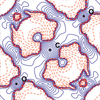issue contents
Special issue on quantum crystallography
Guest editors: Jean-Michel Gillet and Piero Macchi
This virtual issue collects together articles from QCrOM2020.

Cover illustration: The authors contributing to this special issue all participated in the first quantum crystallography meeting (QCrOM2020) held online in August 2020. The issue brings together articles originally published in Acta Crystallographica Section B between June 2021 and December 2021.

 access
access

 access
access access
access

 access
access





 journal menu
journal menu



































